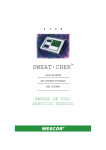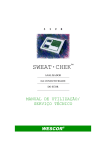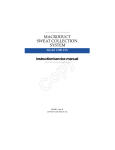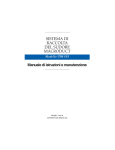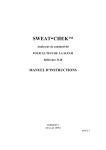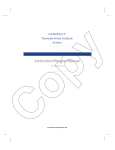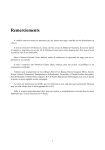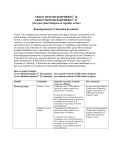Download ADS 3120 Plus Service manual
Transcript
2005-02-11 17:27 Page i SWEAT• CHEK™ SWEAT CONDUCTIVITY ANALYZER op y Model 3120 Instruction/Service Manual M2672-2A C M2672-2A i M2672-2A 2005-02-11 17:27 Page ii © 2005 Wescor, Inc. All rights reserved. Printed in the United States of America. Wescor, Macroduct, Sweat-Chek, Webster Sweat Inducer and Calibrator are trademarks of Wescor, Inc. Other trade names used in this manual may be trademarks of their respective owners, used here for information only. U.S. Patent Numbers 4,383,529; 4,542,751. U.K. Patent Number 2,116,850. German Patent (DBP) 33 09 273. All information in this manual is subject to change without prior notice. ii M2672-2A 2005-02-11 17:27 Page iii section 1 INTRODUCTION 1.1 1.2 1.3 1.4 Instrument Description . . . Customer Service . . . . . Controls and Connections . Important User Information. . . . . . . . . . . . . 3 4 5 6 . . . . . . . . . . . . . . . . . . . . . . . . . 9 11 13 14 . . . . . . . . . . . . . . . . . . . . . . . . . . . . . . . . . . . . . . . . . . . . . . . . . . . . . . . . . . . . . . . . . . . . . . . . . . . . . . . . . . . . . . . . . . . . . . . . section 2 OPERATING SWEAT•CHEK 2.1 2.2 2.3 2.4 Instrument Preparation . . . . Sweat Analysis . . . . . . . . Cleaning the Conductivity Cell . System Operating Checks . . . . . . . . . . . . . . . . . . . . . . . . . . . . . . . . . . . . . . . . . . . . . . . . . . . . . . . . . . . . . . . . . . . . . . . . . . . . . . section 3 INTERPRETATION OF RESULTS 3.1 3.2 3.3 3.4 3.5 3.6 Background . . . . . . . . . . . . . . . . . . . Units of Measurement and Clinical Ranges . . . Conductivity and the CAP Survey Program . . . Conductivity in the Diagnostic Analysis of Sweat . Reportable Range and Its Justification . . . . . . References . . . . . . . . . . . . . . . . . . . . . . . . . . . . . . . . . . . . . . . . . . . . . . . . . . . . . . . . . . . . . . . . . . . . . . . . . . . . . . . . . . . . . . . . . . . . . . . . . . . . . . . . . . . . . . . . . . . 17 19 21 23 25 26 section 4 TROUBLESHOOTING AND SERVICE 4.1 Troubleshooting and Service Overview 4.2 Instrument Calibration . . . . . . . . . 4.3 Replacing the Conductivity Cell . . . . . . . . . . . . . . . . . . . . . . . . . 29 30 33 . . . . . . . . . . . . . . . . . . . . . . . . . . . . . . 37 . . . . . . . . . . . . . . . . . . . . . . . . . . . . . . . . . . . . . . . . . . APPENDIX A Instrument Specifications . APPENDIX B Accessories, Supplies, and Replacement Parts . . . . . . . . . . . . . . . . . . . 41 . . . . . . . . . . . . . . . . . . . . . . . . . . . . 45 . . . . . . . . . . . . . . . . . . . . . . . . . . . . . . . . . . . . . . . 49 APPENDIX C Changing the Voltage Selector INDEX iii M2672-2A iv 2005-02-11 17:27 Page iv M2672-2A 2005-02-11 17:27 Page 1 S E C T I O N 1 INTRODUCTION 1 M2672-2A 2005-02-11 S E C T I O N 17:28 Page 2 1 INTRODUCTION 1.1 Instrument Description 3120 SWEAT• CHEK Sweat Conductivity Analyzer 2 M2672-2A 2005-02-11 17:28 Page 3 S E C T I O N 1 INTRODUCTION 1.1 Instrument Description The 3120 SWEAT•CHEK Sweat Conductivity Analyzer provides simple and economical sweat analysis for the laboratory diagnosis of cystic fibrosis. Designed specifically for use with the Wescor Macroduct® Sweat Collector, it can measure the electrolyte concentration of a sweat specimen as small as 6 to 10 microliters. The Analyzer’s flow-through conductivity cell operates at a precisely controlled temperature for improved stability and accuracy. In keeping with established practice, the readout on the digital display is calibrated in mmol/L (equivalent NaCl). The reading obtained represents the molar concentration of sodium chloride in aqueous solution that would exhibit, at the sample temperature, the observed sample conductivity. The conductivity cell is located beneath a recessed cover on the front panel of the instrument, just below the digital display. In the recess of this cover, two short 0.76 mm diameter stainless steel nipples serve as inlet and outlet connections to the cell. For measurement, two short lengths of microbore plastic tubing are slipped over the stainless steel nipples. One of these tubes is from the Macroduct sweat collector and contains the sweat specimen to be analyzed. The other tube serves as the “takeup” tube. During analysis, the sweat specimen is transferred from the Macroduct tube into the takeup tube via the conductivity cell. After the sweat specimen is transferred into the cell, its electrical conductivity is measured, the electrolyte concentration is calculated, and the result appears on the digital display. Complete instructions for this procedure are found in Section 2. 3 M2672-2A 2005-02-11 S E C T I O N 17:28 Page 4 1 INTRODUCTION 1.2 Customer Service Wescor is ready to help you resolve any problems with your SWEAT•CHEK Analyzer. If you cannot solve a problem using the procedures in this manual please contact us. Customers within the United States and Canada are encouraged to contact us by telephone. Outside the U.S., many of our authorized dealers offer complete customer service and support. Contact Wescor by mail, telephone, fax or email at the address and numbers listed below. Wescor, Inc 459 South Main Street Logan, Utah 84321-5294 USA TELEPHONE: (435) 752 6011 TOLL FREE: (800) 453 2725 (U.S. and Canada) FAX: (435) 752 4127 E-MAIL: [email protected] WEBSITE: www.wescor.com NOTE: Wescor’s Authorized European Representative for matters relating to the Medical Device Directive is: MT Promedt Consulting GmbH Altenhofstraße 80 D-66386 St. Ingbert, Germany Tel: +49 6894 581020 Fax: +49 6894 581021 email: [email protected] www.mt.procons.com 4 M2672-2A 2005-02-11 17:28 Page 5 S E C T I O N 1 INTRODUCTION 1.3 Controls and Connections DIGITAL DISPLAY INSTRUMENT FRONT INLET/OUTLET NIPPLES WAIT INDICATOR READY INDICATOR CONDUCTIVITY CELL POWER INDICATOR INSTRUMENT REAR CALIBRATING TOOL MODEL AND SERIAL NUMBER POWER CORD RECEPTACLE POWER SWITCH CALIBRATION PORT POWER ENTRY MODULE The power switch is located on the back of the instrument as part of the Power Entry Module. When connected to the proper line voltage and turned ON (I) the power indicator should glow GREEN. 5 M2672-2A 2005-02-11 S E C T I O N 17:28 Page 6 1 INTRODUCTION 1.4 Important User Information SPECIFICATION OF SAFE USE: Using this instrument in a manner not specified by Wescor may impair the safety protection designed into the equipment and may lead to injury. SAFE USE ENVIRONMENT: This device has been designed for indoor use only, between 5 and 40 °C, maximum relative humidity 80%, at up to 31 °C. For use at altitudes up to 2000 meters. FUSES: All fuses in this equipment are time-lag (Type T). For use with a Mains Supply voltage of 85 to 264 Volts AC @ 50 to 60 Hz, ±10%. Transient Overvoltage Category II. Pollution Degree 2 in accordance with IEC 664. EXPLANATION OF SYMBOLS FOUND ON EQUIPMENT: ∼ Alternating Current (AC) I Power On O Power Off International Attention Symbol. Calls attention to important information and instructions in the instruction manual. 6 M2672-2A 2005-02-11 17:28 Page 7 S E C T I O N 2 OPERATING SWEAT•CHEK 7 M2672-2A 8 2005-02-11 17:28 Page 8 M2672-2A 2005-02-11 17:28 Page 9 S E C T I O N 2 OPERATING SWEAT•CHEK 2.1 Instrument Preparation 1 The power switch is located on the back panel in the power entry module. Make certain the switch is OFF (0). 2 Plug the female end of the power cord into the power entry module. Note the voltage indicator window. If the voltage does not match the voltage of your power outlet, refer to Appendix C before proceeding. NOTE: We recommend using a grounded power line surge protector to isolate the instrument from spikes and surges. 3 Plug the male end of the power cord into a grounded power outlet. 4 Turn the power switch on (I). The power indicator should glow GREEN. The display will read zero: The WAIT indicator glows amber. Within two minutes, it will switch off and the READY indicator will glow green, indicating that the conductivity cell has stabilized at the correct operating temperature. The Analyzer is now ready to accept samples. 9 M2672-2A 2005-02-11 S E C T I O N 17:28 Page 10 2 OPERATING SWEAT•CHEK 2.1 Instrument Preparation 10 5 Attach a length of clean microbore tubing (SS044) to serve as the outlet tube to one of the stainless steel nipples. While either nipple can be used, we suggest that the right hand nipple be used as the outlet. 6 Check calibration before introducing specimen, (see Section 2.4). After calibration (if needed), clean and dry the cell before proceeding with analysis, (see Section 2.3). 7 Attach the tube containing the specimen for analysis to the opposite (we recommend the left) nipple, which will serve as the inlet. See Section 2.2 for complete instructions. M2672-2A 2005-02-11 17:28 Page 11 S E C T I O N 2 OPERATING SWEAT•CHEK 2.2 Sweat Analysis The Macroduct Sweat Collection System manual provides complete instructions for sweat collection. These should be followed rigorously. Normally, the sweat specimen is introduced directly into the conductivity cell from the Macroduct collection tube. A typical Macroduct sweat collection produces many times the sweat volume needed for analysis. In cases where sweat yield is below average, measurement is possible using 6 to 10 microliters of sweat; but careful and precise technique is mandatory, since positioning of the sample within the cell becomes critical. If the sample volume is insufficient to establish continuity between the electrodes in the conductivity cell (approximately 6 microliters), no measurement will be possible. However, any reading sustained on the digital display for at least a few seconds will be valid. PREVIOUSLY COLLECTED SWEAT OR SWEAT CONTROLS If the sweat specimen has been transferred to a storage cup, or if you wish to inject Calibrator solution (SS-140), sweat control solutions (SS-150), or water into the Analyzer, simply attach a spare take-up tube to the syringe. Position the syringe plunger near mid-point, and carefully withdraw the plunger to bring the specimen into the tube. Use only new, clean tubing that is certified solute-free to avoid measurement errors (tubing supplied by Wescor meets this requirement). Do not aspirate liquid into the syringe body. NOTE: Handle the sweat specimen with care before analysis to avoid introducing air bubbles into the sweat column. An air bubble in the conductivity cell will prevent measurement. the end of the specimen tube to the inlet nip1 Connect ple of the conductivity cell (we suggest the left hand nipple). Push tubing “straight on” the nipple. 11 M2672-2A 2005-02-11 S E C T I O N 17:29 Page 12 2 OPERATING SWEAT•CHEK 2.2 Sweat Analysis CAUTION! Push the tubing STRAIGHT ON to the stainless steel nipples without bending them. Repeated bending will eventually cause the nipple to fracture, requiring replacement of the conductivity cell. the specimen into the cell by gently moving 2 Transfer the syringe plunger into its barrel. When the liquid column of the specimen makes contact with the cell electrodes, the digital display will rise quickly from its zero reading. Stop injecting the sample at this point, and the sample will rapidly equilibrate to the cell temperature. Moving the liquid column brings cooler liquid into the conductivity cell, briefly producing a lower reading, but the reading quickly stabilizes when motion ceases. In large samples, a slight beginning-to-end conductivity variation is normal. See Section 3.2 to interpret readings. the liquid column of the specimen loses con3 When tact with the first cell electrode, the reading will fall to zero. desired, the specimen can be drawn back into the 4 Ifcell to repeat the measurement. If the plunger is moved smoothly and gently, the specimen can be transferred in and out of the conductivity cell for as many measurements as desired. Abrupt, jerky movements of the plunger can separate the liquid column, and the resulting air bubbles will interrupt readings as they pass through the cell. clean and dry the conductivity cell using the 5 Thoroughly instructions in Section 2.3. 12 M2672-2A 2005-02-11 17:29 Page 13 S E C T I O N 2 OPERATING SWEAT•CHEK 2.3 Cleaning the Conductivity Cell 1 After testing each specimen, rinse the conductivity cell with at least one full take-up tube of deionized water. 2 When all residual salt has been flushed from the cell, the reading on the display reads “000” (with pure water in the cell). 3 Remove water by using the syringe to push air through the cell. After all discernible liquid has been flushed, remove the take-up tube and “pump” the syringe to blow out any remaining micro droplets and dry the cell. Finally, push the syringe plunger completely down to purge remaining droplets of water from the cell. This procedure is necessary to ensure accuracy of any subsequent measurement. CAUTION! Never allow any liquid to remain in the conductivity cell after measurements are complete. Besides risking a measurement artifact in the next procedure, the instrument can be damaged if it is inadvertently exposed to freezing temperatures such as could occur during transport to a testing site in cold weather. To avoid damage to the cell or other sensitive electronic components, do not expose the instrument to extremes of heat or cold. 13 M2672-2A 2005-02-11 S E C T I O N 17:29 Page 14 2 OPERATING SWEAT•CHEK 2.4 System Operating Checks SWEAT•CHEK is factory-calibrated and under normal conditions should not require further adjustment. IF THE CELL IS CLEAN AND FREE OF RESIDUAL SALT OR WATER, calibration of the instrument can be checked using a freshly opened NaCl standard solution such as that initially supplied with the instrument. The reading given by the Analyzer should agree with the specified molarity of the standard solution within ± 2 mmol/L. If recalibration becomes necessary refer to Section 4.2. SWEAT•CHEK has an extremely stable response characteristic that is virtually linear through the critical range from 75 to 110 mmol/L. At extremely low ranges, there will be a slight positive error in the reading, and at extremely high ranges, a slight negative error. These errors will not invalidate the diagnostic result. See Section 3.5. Check calibration to ascertain that the temperature of the cell is within the correct range and that the electronics are otherwise functioning normally. A reading that agrees with the labeled value of the standard solution indicates correct overall performance to a very high level of confidence. Further testing is not normally necessary. Sweat Controls Normal Appr. 40 mmol/L High Normal/Equivocal Appr. 70 mmol/L If you require a CF-positive and/or CF-negative control value, Wescor Sweat Controls (SS-150) provide three levels of control for validating measurements of electrolyte concentration as shown at left: Abnormal Appr. 130 mmol/L CAUTION! Push the tubing STRAIGHT ON to the stainless steel nipples without bending them. Repeated bending will eventually cause the nipple to fracture, requiring replacement of the conductivity cell. 14 M2672-2A 2005-02-11 17:29 Page 15 S E C T I O N 3 INTERPRETATION OF RESULTS 15 M2672-2A 16 2005-02-11 17:29 Page 16 M2672-2A 2005-02-11 17:29 Page 17 S E C T I O N 3 INTERPRETATION OF RESULTS 3.1 Background Children afflicted with cystic fibrosis (CF) clearly show elevated electrolyte concentrations in their sweat, compared with the sweat of children unaffected by this disease.1,2 With increasing age, however, the difference between normal and abnormal sweat electrolyte levels becomes less distinct; thus, the borderline and low abnormal results commonly encountered in adults are not indicative of disease. A diagnosis of CF will always be based upon clinical findings and observations, but the “laboratory diagnosis” or “sweat test,” performed properly, provides valuable quantitative corroboration of the physician’s clinical diagnosis. Historically, the “sweat test” was performed without Macroduct and SWEAT•CHEK and has shown a high incidence of both false positive and false negative results, with false positives predominating. The professional literature3,4,5 has been highly critical of various commercial systems that purport to simplify one or more of the three steps in the procedure, i.e. SWEAT INDUCTION, SWEAT COLLECTION and SWEAT ANALYSIS. Most of the errors involved the collection phase of the test. Webster’s comprehensive review of quantitative sweat testing, from the early 1950’s through 1983, identified error factors associated with each of these methods.6 Although numerous sweat testing systems have been marketed, the Cystic Fibrosis Foundation of America has approved only two methods of sweat collection. They are the original pad absorption method of Gibson and Cooke7 and the Wescor Macroduct Sweat Collection System.8,9 The sweat test’s analytical phase was limited to chloride ion assay in laboratories of the early 1950’s. Today, laboratory technologists can choose from a number of alternative analytical methods, including anion assay, cation assay, osmolality, or electrical conductivity. The SWEAT•CHEK Sweat Conductivity Analyzer measures the electrolyte concentration of the specimen by electrical conductivity. 17 M2672-2A 2005-02-11 S E C T I O N 17:29 Page 18 3 INTERPRETATION OF RESULTS 3.1 Background Licht,10 Gibson,11 Phillips,12 Shwachman,13 and others extensively investigated conductivity as an alternative method of sweat analysis. They concluded that conductivity can be a reliable laboratory indicator to either rule out or confirm the clinical diagnosis of cystic fibrosis. See Section 3.4 for more information on the status of conductivity. The designs of earlier sweat conductivity measuring instruments were lacking in terms of specimen handling, calibration stability, and measurement resolution. The SWEAT•CHEK Sweat Conductivity Analyzer, with its temperature-controlled measurement cell, flow-through operation, and wide-range digital readout, is a modern adaptation of a proven analytical method. One of the world’s leading authorities on sweat testing, commenting on SWEAT•CHEK stated, “If this machine is kept clean, it gives results that are every bit as reliable as an analysis for sodium or chloride.”14 18 M2672-2A 2005-02-11 17:29 Page 19 S E C T I O N 3 INTERPRETATION OF RESULTS 3.2 Units of Measurement and Clinical Ranges In addition to sodium and chloride ions, sweat also contains significant concentrations of potassium, bicarbonate, and lactate ions. This poses a problem when selecting a reference or calibration solution, but sodium chloride solutions serve well if allowance is made for the other electrolytes. Thus, the reference ranges for electrolyte concentration in normal and abnormal groups, in terms of sodium chloride standards, will differ from those established for specific assay of chloride ions. SWEAT•CHEK was evaluated at three separate medical centers in studies of 514 patients, among whom were 43 clinically confirmed cases of cystic fibrosis.15 Analysis of the combined data is shown on the following page (Table 3-1). The normal, borderline and abnormal electrolyte concentration ranges were established by reference to the data published by Hammond et.al.15, using their equation relating electrolyte concentration to chloride: ELECTROLYTE CONCENTRATION (USING SWEATCHEK) Normal 0-60 Borderline 60-80 Abnormal 80+ (mmol/L) CHLORIDE Normal 0-40 Borderline 40-60 Abnormal 60+ (mmol/L) Readings on Sweat-Chek classified and compared to chloride analysis. Bias = Electrolyte Concentration (conductivity) - Chloride The bias (unmeasured anions) was observed to be a function of the conductivity value, and this enabled converting chloride range-limiting levels of 40 to 60 mmol/L to their electrolyte conductivity equivalents shown in the accompanying table. Carefully assess any result in the “borderline” region between 60 and 80 mmol/L. Factors such as age, state of hydration, family history of CF, etc., must be assessed by the attending physician, together with the sweat analytical data. Retesting, along with alternative methods of analysis, such as chloride or sodium ion assay, may help resolve an equivocal sweat test result. It has been shown that the concentration of electrolytes decreases as sweating continues in time.11 If the sweat yield during collection is 30 microliters or more (typical yield is 50 to 60 microliters in 30 minutes using Macroduct), then an increase in the reading may be observed as the sweat column passes from the Macroduct collection tube through the conductivity cell into the “take-up” tube. The variation will be small in comparison with the difference between normal and abnormal sweat, and thus will not confound the diagnosis. 19 M2672-2A 2005-02-11 S E C T I O N 17:29 Page 20 3 INTERPRETATION OF RESULTS 3.2 Units of Measurement and Clinical Ranges Among the patient populations mentioned above, data on chloride ion assay and sodium plus potassium ion assay, determined simultaneously with the conductivity data, enables linear regression analysis: Chloride Ion Concentration VS. Sweat Conductivity n = 514 r = 0.974 Cl¯ = 0.96 (C) -15.21 Sodium + Potassium Ion Concentration VS. Sweat Conductivity n = 514 r = 0.987 Na+ + K+ = 0.974 (C) - 1.49 C = (electrolyte concentration equivalent NaCl mmol/L) Table 3-1 CLINICAL RANGES SWEAT CONDUCTIVITY AS EQUIVALENT NaCl (mmol/L) Number of Patients Mean Value Standard Deviation Observed Range 20 Non CF CF 471 33.4 11.2 13-87 43 113.1 9.9 90-136 M2672-2A 2005-02-11 17:29 Page 21 S E C T I O N 3 INTERPRETATION OF RESULTS 3.3 Conductivity and the CAP Survey Program The readout in mmol/L (equivalent NaCl) means that the sweat sample has a conductivity equivalent to that of a NaCl solution of the displayed mmol/L concentration (at the same temperature). This reading DOES NOT represent the actual concentration of either sodium or chloride in the sweat. The level of electrical conductivity is a direct function of the concentration of ionized molecules in a solution. Sweat samples are made up of sodium, potassium, and a small amount of ammonium, as the cation contribution. The anions balancing these are mainly chloride, with lactate and bicarbonate. Thus, the conductivity can be seen as a measure of the total electrolyte concentration in mmol/L. The electrolyte selected for calibration reference is sodium chloride but it could be any other salt. The chemical nature of the calibration solution is immaterial, because the reference ranges for sweat conductivity will be based upon comparison with the calibration value, and will be valid whatever electrolyte is used as a reference. Conductivity in the CAP Sweat Survey Program Regrettably, in the CAP Survey Program, some Sweat-Chek users continue to present their sweat conductivity results in the survey section meant for those labs that specifically measure chloride by one method or another. Prior to 1997, when the CAP samples were pure NaCl solutions, this practice did not lead to a problem in terms of numerical value of conductivity as compared with the chloride value because the sample only contained NaCl. However, when laboratories were asked to make diagnostic judgments on the basis of their results, it did create a serious problem for those mistakenly submitting conductivity as chloride. These laboratories did not appear to recognize that by submitting their data to the chloride section their results would be assessed in terms of the accepted diagnostic ranges for chloride. Since conductivity ranges are different from chloride ranges due to the presence of significant amounts of non-chloride ions in sweat, this usually resulted in an apparent misdiagnosis as far as the CAP Survey was concerned. 21 M2672-2A 2005-02-11 S E C T I O N 17:29 Page 22 3 INTERPRETATION OF RESULTS 3.3 Conductivity and the CAP Survey Program For example, a laboratory finding a conductivity result of 70 mmol/L (equiv. NaCl) would judge this as an equivocal result in terms of the recommended diagnostic ranges for conductivity based on clinical trials. If it had been properly presented to the conductivity section of the Survey, it would be correctly judged by its peer group (conductivity users) as equivocal. However, if it were placed in the CAP section meant specifically for chloride measurers, it would be viewed as a false diagnosis, because a level of 70 mmol/L is a positive result for chloride. In 1997 the CAP replaced pure NaCl solutions with simulated sweat samples for analysis in the assessment of laboratory competence. This was accomplished by the addition, to the basic NaCl, of a representative quantity of other salts to produce a total electrolyte content similar to sweat in each of the three diagnostic categories. This was a long awaited and much welcomed move. However, it must be understood that in all three simulated sample groups, low, medium, and high in electrolyte content, the chloride content will be, as in sweat, lower than the total anion content and therefore lower than the conductivity value. For this reason, all conductivity results that are included in and compared with the data of the chloride-analyzing group of laboratories will apparently be significantly in error. Consequently, it remains extremely important that those laboratories that wrongly present conductivity results to the chloride section must desist from this practice. When properly included in the conductivity section, the results will be seen in relation to and compared with those of peer laboratories. 22 M2672-2A 2005-02-11 17:29 Page 23 S E C T I O N 3 INTERPRETATION OF RESULTS 3.4 Conductivity in the Diagnostic Analysis of Sweat Recently much confusion has arisen in laboratory departments after the publication of the recommendations of the National Committee for Clinical Laboratory Standards, (Sweat Testing Guideline C34-A) that have been adopted by the Cystic Fibrosis Foundation of America. The Foundation did not recognize electrical conductivity as a diagnostic analytical procedure in sweat testing. Rather, conductivity is relegated to a screening procedure only. Accordingly, Sweat-Chek is not accepted for use in the Care Centers under its control. Until 2000, NCCLS also advised that a patient with a sweat conductivity result of 50 mmol/L or higher should be referred to an accredited CF care center for a sweat chloride analysis, and on page 21 of Guideline C34-A (1994) one found the following statement: “Any sweat conductivity result greater than or equal to 50 mmol/L (equivalent sodium chloride, NaCl) is considered positive.” Reference to the Hammond, et. al. sweat data15 shows that 50 mmol/L conductivity is in fact equivalent to 28 mmol/L chloride, a value that does not fall into either the positive or equivocal compass, but is well within the normal range for chloride. Wescor brought this to the attention of the Foundation and in the Revised NCCLS Guideline C34-A2 (2000) the referenced statement had been removed. The rationale for the Foundation’s position is not readily apparent. If, as it would seem, it stems from their statement that conductivity is to be regarded as only a screening test, there is no support for this premise in the scientific literature. A thorough perusal of the Hammond paper fails to reveal any basis for such an interpretation15, 16. On the contrary, we submit the following quotation from Shwachman and Mahmoodian in the paper published in 1967: “The standard conductivity measurement is made immediately after the collection of sweat and provides an instant answer... The correlation between this measurement and the electrolyte concentration is excellent and every patient with cystic fibrosis tested was properly identified. No individuals were falsely diagnosed. The rarely encountered borderline case by one method gives the same borderline value by the other method.”17 23 M2672-2A 2005-02-11 S E C T I O N 17:29 Page 24 3 INTERPRETATION OF RESULTS 3.4 Conductivity in the Diagnostic Analysis of Sweat Further, a comparative statistical analysis of the extensive chloride data of Shwachman,17 the Macroduct trial results of various electrolytes versus conductivity by Hammond, and osmolality results from Webster clearly shows that conductivity, chloride, and osmolality are equivalent in their ability to discriminate between non-CF and CF groups. These statistics were presented in a poster at the 5th International Conference on Neonatal Screening for Cystic Fibrosis, Caen (France), 1998.18 Finally, a recent large scale study (3834 subjects) has shown convincing correlation between conductivity and chloride concentration. This study identified conductivity values associated with normal and CF positive with the normal cutoff being <75 mmol/L and CF diagnosis confirmed at ≥ 90 mmol/L.19 Wescor makes no pretense of authority in setting, determining, or influencing reference ranges, being content to defer to the collected research of the medical community. However, an objective reading of the extant studies on the subject seem to agree, with some slight variations from study to study, that it is quite reasonable to assume that the upper limit of normal would be >70 mmol/L, and that >90mmol/L would be a positive indication for CF. Further, we are confident that the Sweat Chek Analyzer can accurately indicate a patient’s true sweat conductivity values whatever the accepted and established ranges might be. 24 M2672-2A 2005-02-11 17:29 Page 25 S E C T I O N 3 INTERPRETATION OF RESULTS 3.5 Reportable Range and its Justification The following information is provided to help you meet regulatory and quality requirements: 1. Reportable Range The reportable range with Sweat-Chek conductivity measurement is 0 to 150 mmol/L, defined as the range of values that have been established as providing acceptably accurate laboratory results for the intended clinical use. 2. Linearity of Conductivity Versus Electrolyte Concentration Data produced by Wescor using the Sweat-Chek analyzer is based upon the calibration of the instrument at one point only: 90 mmol/L (equivalent NaCl), then recording the readings given by standard NaCl solutions ranging from 0 to 150 mmol/L. The calibration point of 90 mmol/L was selected since it coincides approximately with the middle point of the complete range and with the lowest published values for CF subjects. The results show that the response is reasonably linear from 20 to 90 mmol/L. The error in this range is relatively constant and represents an overestimate of the true value by about 2 mmol/L reducing to zero at 90 mmol/L. In the range 90 to 140 mmol/L the error becomes an underestimate that increases regularly from zero at 90 mmol/L to 6 mmol/L below the true value at 140 mmol/L, (a range that corresponds with the clinically recorded span of CF values). 3. Justification for Reportable Range The designation acceptably accurate referred to above is applied for the following reasons: For control patients in the normal range (0 to 60 mmol/L) the constant overestimate (+2 mmol/L) is too small to convert a normal result into a frankly borderline result. For borderline patients (60 to 80 mmol/L), the measured value is a constant overestimate, at about 1 to 2 mmol/L and is again much too small to convert a borderline into a positive result. For positive (greater than 80 mmol/L), CF subjects, the error is an underestimate and variable, negligible in the critical range of 80 to 110 mmol/L, and maximal in the upper part of the abnormal range (140 mmol/L) where it cannot in any way effect the diagnosis. 25 M2672-2A 2005-02-11 S E C T I O N 17:29 Page 26 3 INTERPRETATION OF RESULTS 3.6 References References 1. di Sant’ Agnese, P.A., Darling, R.C., Perera, G.A., Shea, E., Sweat electrolyte disturbances associated with childhood pancreatic disease. Am J Med, 1953;777-784. 2. Clarke, J.T., Ellian, E., Shwachman, H., Components of sweat. Am J Dis Child 1961;101:490. 3. Gibson, L.E., The decline of the sweat test. Clin Pediatr 1973;12:450. 4. Rosenstein, B.J., Langbaum, T.S., Gordes, E., Brusilow, S.W., Cystic Fibrosis: problems encountered with sweat testing. JAMA 1978;1987:240. 5. Denning, C.R., Huang, N.N., Cuasay, L.R., Shwachman, H., Tocci, P., Warwick, W.J., Gibson, L.E., Cooperative study comparing three methods of performing sweat tests to diagnose cystic fibrosis. Pediatrics 1980;66:752. 6. Webster, H.L., Laboratory diagnosis of cystic fibrosis. CRC Crit. Rev. in Clin. Lab. Sci. 1983;18:313338. 7. Gibson, L.,E., Cooke, R.E., A test for concentration of electrolytes in sweat in cystic fibrosis of the pancreas utilizing pilocarpine by iontophoresis. Pediatrics 1959;23:545. 8. Barlow, W.K., Webster, H.L., A simplified method of sweat collection for diagnosis of cystic fibrosis. In Lawson D, ed., Cystic fibrosis: horizons, Proceedings of the 9th International Cystic Fibrosis Congress, Brighton, England, June 9-15, 1984, New York, NY: John Wiley & Sons, 1984:204. 9. Carter, E.P., Barrett, A.D., Heeley, A.F., Kuzemko, J.A., Improved sweat test method for the diagnosis of cystic fibrosis. Arch. Dis. Child. 1984;919-922. 10. Licht, T.S., Stern, M., Shwachman, H., Measurement of the electrical conductivity of sweat. Clin Chem 1957;3:37. 11. Gibson, L.E., di Sant’ Agnese, P.A., Studies of salt excretion in sweat. Relationships between rate, conductivity, and electrolyte composition of sweat from patients with cystic fibrosis and from control subjects. J Pediatr 1963;62: 855. 12. Phillips, W.R., Electrical conductivity of sweat. A simple home-assembled apparatus. Pediatrics 1963;32:89. 13. Shwachman, H., Dunham, R., Phillips, W.R., Electrical conductivity of sweat. A simple diagnostic test in children. Pediatrics 1963;32:85. 14. Gibson, L.E., Private communication. Rush-Presbyterian-St Luke’s Medical Center, Chicago, IL, August 1987, January 1988. 15. Hammond, K. B., Turcios, N. L., and Gibson, L. E., Clinical evaluation of the macroduct sweat collection system and conductivity analyzer in the diagnosis of cystic fibrosis. J Pediatrics, 1994;124: 255-260. 16. Van der Merwa, D., Ubbink, J. B., Deelport, R., Becker, P., Dhatt, G. S. Vermaak, W.J.H.: Biological variation in sweat sodium chloride conductivity. Ann Clin Biochem 2002; 39: 39-43. 17. Shwachman, H., Mahmoodian, A.: Pilocarpine iontophoresis sweat testing. Results of seven years experience. Bibl. Paediatr. 86:158-182, 1967. 18. Webster, H. L., Sweat conductivity is a valid analysis for cystic fibrosis. Proceedings of the International Conference of Neonatal Screening for Cystic Fibrosis. Page 101, Caen, France, 1999. 19. Lezana, J. L., Vargas, M. H., Karam-Bechara, J., Aldana, R. S., Furuya, E. Y., Sweat conductivity and chloride titration for cystic fibrosis in 3834 subjects. Journal of Cystic Fibrosis. 2 (2003) 1-7. 26 M2672-2A 2005-02-11 17:29 Page 27 S E C T I O N 4 TROUBLESHOOTING AND SERVICE 27 M2672-2A 28 2005-02-11 17:29 Page 28 M2672-2A 2005-02-11 17:29 Page 29 S E C T I O N 4 TROUBLESHOOTING AND SERVICE 4.1 Troubleshooting and Service Overview The SWEAT•CHEK analyzer is designed to be simple to operate and easy to maintain. The following troubleshooting chart provides suggestions to help you quickly solve routine problems that might be encountered using the SWEAT•CHEK Analyzer. These solutions are indexed to additional information found in this section. Aside from replacing the conductivity cell, there are no user-serviceable parts inside the instrument case. The analyzer case should never be opened except by qualified service personnel. More difficult problems may require detailed technical service. Contact your dealer or Wescor for assistance. Refer to Section 1.2 for Customer Service information. START Blank display, no LED's lit. Display always reads zero. Check for power to instrument, "POWER" switch in ON position. No sample or an air bubble in sample chamber. Check for proper voltage selection, blown fuses. Check for broken or loose nipple. Low readings, cool sample chamber, no "READY" light. If the above procedures fail to solve the problem then instrument repair is required. (Section 1.2) Hot sample chamber, elevated reading. Replace sample chamber and calibrate instrument. (Sections 4.2 and 4.3) * Performed By Qualified Personnel Only 29 M2672-2A 2005-02-11 S E C T I O N 17:29 Page 30 4 TROUBLESHOOTING AND SERVICE 4.2 Instrument Calibration The instrument must be calibrated if the conductivity cell has been replaced or if you determine that recalibration is needed (see System Operating Checks, Section 2.4). Two common factors can influence the reading, so before performing recalibration, be sure to check the following: A. RESIDUAL SALT OR WATER IN THE CONDUCTIVITY CELL. If the cell is not rinsed thoroughly after testing sweat or saline solutions, residual salt may be left in the cell. This tends to increase the reading on a subsequent specimen. Rinse water must be purged from the cell after rinsing, or it may dilute a subsequent specimen, causing a decreased reading. Make certain the cell is clean and dry before calibrating or processing samples. B. CONCENTRATED CHECK SOLUTION NaCl standard solutions tend to concentrate whenever the contents are exposed to the atmosphere. If you doubt the validity of the Calibrator solution, use a freshly-opened ampule before proceeding. 30 M2672-2A 2005-02-11 17:29 Page 31 S E C T I O N 4 TROUBLESHOOTING AND SERVICE 4.2 Instrument Calibration If you have eliminated the possibility of error from other sources, and recalibration is indicated, the procedure is as follows: CALIBRATOR SOLUTION INTO THE CON1 INJECT DUCTIVITY CELL. a. Connect a new tube (Wescor catalog number SS-044) to the outlet (right) nipple of the cell. b. Attach a second new tube to the blunt-end needle of the syringe, and draw a specimen directly from the calibrator ampule into the tube (do not draw solution into the syringe). c. Connect the syringe tube to the inlet (left) nipple of the cell. d. Gently move the syringe plunger to transfer the Calibrator solution into the conductivity cell. The reading will stabilize in approximately 10 seconds. 31 M2672-2A 2005-02-11 S E C T I O N 17:29 Page 32 4 TROUBLESHOOTING AND SERVICE 4.2 Instrument Calibration CALIBRATION 2 ADJUST Insert the small end of the calibration tool into the small calibration port on the left side of the analyzer. With the tool seated in the small slot in the bottom of the port, observe the display while rotating the tool in either direction until the display agrees with the assayed molarity of the Calibrator solution. 3 RE-CHECK CALIBRATION To double check calibration you should repeat steps a though d. THE CONDUCTIVITY CELL 4 CLEAN Flush the conductivity cell with deionized water, followed by bursts of air to purge any remaining droplets (see Cleaning the Conductivity Cell, Section 2.3). 32 M2672-2A 2005-02-11 17:29 Page 33 S E C T I O N 4 TROUBLESHOOTING AND SERVICE 4.3 Replacing the Conductivity Cell If one of the stainless steel nipples of the conductivity cell breaks, you must replace the cell assembly (see Appendix C for details). Use the following procedure: 1 Switch the instrument off and disconnect line power. 2 Remove the cell cover. a. Remove the small Phillips-head screws located in the recess of the cover on each side of the nipples. b. Check to see that the nipples are parallel with each other and perpendicular to the cover. c. Carefully lift the cover away from the front panel, sliding it off the nipples as it comes forward. 3 Remove the conductivity cell. NOTE: Do not remove the two small screws that are located near the nipples on the printed circuit board of the cell assembly. The cell is held in place by a circuit board connector. Carefully insert needle-nose pliers in the holes provided in the circuit board. Disconnect the circuit board from the connector by gently gripping the pliers and pulling the circuit board straight out. Do this carefully to avoid damage to the circuit board or the connector. 33 M2672-2A 2005-02-11 S E C T I O N 17:29 Page 34 4 TROUBLESHOOTING AND SERVICE 4.3 Replacing the Conductivity Cell 4 5 6 34 INSTALL THE NEW CONDUCTIVITY CELL Make certain that the nipples of the new cell assembly align precisely with the holes in the cover before installing the cell in the instrument. Hold the circuit board with needle-nose pliers. Then, position the cell so that its connector engages properly with the pins protruding from the circuit board connector inside the instrument. Gently press the cell down until it seats against the connector. REPLACE THE CELL COVER Make sure both cell cover mounting screws pass completely through the holes in the cell to engage the threaded stand offs. CALIBRATE THE NEW CONDUCTIVITY CELL Follow the procedure under “Instrument Calibration” (Section 4.2). M2672-2A 2005-02-11 17:29 Page 35 A P P E N D I X A INSTRUMENT SPECIFICATIONS 35 M2672-2A 36 2005-02-11 17:29 Page 36 M2672-2A 2005-02-11 17:29 Page 37 APPENDIX A Instrument Specifications Minimum Sample Volume Accuracy Useful Range Critical Range/Linear Error Sample Stabilization Time Cell Warm-up Time Readout Calibration Reference Cell Set Temperature Line Voltage Options* Power Fuse Dimensions Weight 6-10 microliters 2 mmol/L (1 S.D.) 0 to 150 mmol/L Less than 2% (in the range from 75 to 110 mmol/L) Approximately 10 seconds Approximately 1 minute after power-up 3 1/2 digit liquid crystal display Standard NaCl solution 39.5 °C ± 0.2 °C 100 to 120 V, or 220 to 240 V nominal, (Set at factory, user-selectable with fuse change) 50-60 Hz Transient Overvoltage Category II Less than 10 Watts 1/4 Amp time-lag 3AG (Type T) (100 to 120 V) (2 required) 1/8 Amp* time-lag 3AG (Type T) (220 to 240 V) (2 required) 10 cm x 20 cm x 16 cm 1.0 kg * Make sure that the voltage specification on the rear panel of the Analyzer matches the local line voltage before connecting to electrical power. This device is designed for indoor use only between 4 and 40 °C, Maximum relative humidity of 80% at up to 31 °C. For use at altitudes up to 2000 meters. 37 M2672-2A 38 2005-02-11 17:29 Page 38 M2672-2A 2005-02-11 17:29 Page 39 A P P E N D I X B ACCESSORIES, SUPPLIES, AND REPLACEMENT PARTS 39 M2672-2A 40 2005-02-11 17:29 Page 40 M2672-2A 2005-02-11 17:29 Page 41 APPENDIX B Accessories, Supplies, and Replacement Parts Contact Wescor for a complete list of replacement parts. ACCESSORIES Ampule Organizer for Calibrator and Sweat Controls AC-071 SUPPLIES Deionized water, 60 mL dropper bottle Take-Up Tube microbore plastic tubing (package of 100) Syringe/Needle Set (package of three 1 mL syringes with #22 blunt end needles) Calibrator for SWEAT•CHEK Conductivity Analyzer (package of 60 ampules) Molarity 90 mmol/L Sweat Controls: Sweat Controls 1, 2, 3, 0.75 mL vial (package of 36, 12 each of Control 1, 2, 3) Sweat Control 1 molarity is approximately 40 mmol/L. Sweat Control 2 molarity is approximately 70 mmol/L. Sweat Control 3 molarity is approximately 130 mmol/L. Each Sweat Control lot has a specific control value and range. SS-006 SS-044 SS-045 SS-140 SS-150 REPLACEMENT PARTS Conductivity Cell, Model 3120 Conductivity Cell Cover, Model 3120 Main Printed Circuit Board Assembly, Model 3120 RP-190 120943 330947-01 MANUAL 3120 SWEAT•CHEK Conductivity Analyzer Instruction/Service Manual M2672 41 M2672-2A 42 2005-02-11 17:29 Page 42 M2672-2A 2005-02-11 17:29 Page 43 A P P E N D I X C CHANGING THE VOLTAGE SELECTOR 43 M2672-2A 44 2005-02-11 17:29 Page 44 M2672-2A 2005-02-11 17:29 Page 45 APPENDIX C Changing the Voltage Selector The voltage setting is designated at the factory before shipping. If the voltage shown does not match your power outlet, you must change the voltage selector before plugging the instrument into the outlet. To change the voltage selector: 1 Switch the power off and remove the power cord from the power entry module. 2 Use a screwdriver to open the fuse access door from the right end of the power entry module. 3 Use the screwdriver to pry the red voltage indicator (also from the right side) from the power entry module. 4 Rotate the indicator until the correct voltage appears in the indicator window, then press it back into the module until it clicks into place. NOTE: If necessary, change the fuses to match the new voltage setting. 100 or 120 V Setting: 1/4 Amp time-lag type (Type T) fuses (2 required). 220 or 240 V Setting: 1/8 Amp time-lag type (Type T) fuses (2 required). 5 Close the module door and check to ensure the correct voltage appears in the indicator window. 45 M2672-2A 46 2005-02-11 17:29 Page 46 M2672-2A 2005-02-11 17:29 Page 47 INDEX 47 M2672-2A 48 2005-02-11 17:29 Page 48 M2672-2A 2005-02-11 17:29 Page 49 INDEX A Abnormal Results 19 Air bubbles 11, 12 Ampule organizer 41 Anion Assay 17 Control values 17 Customer service 4, 29 Cystic fibrosis 3, 14, 17, 19 clinical diagnosis of 3, 17, 19 clinical data 19, 20 laboratory confirmation of 17 B Bicarbonate ions in sweat 19 Borderline (see also Equivocal) Results 19, 25 D Diagnostic result 14 Digital display 3, 5, 9, 11, 13, 23, 25, 29 C Calibration 10, 14, 30-32, 34 port 5, 32 reference 30 solution 11, 19, 30-32 tool 5, 32 CAP Survey Program 21 Cation assay 17 Chloride ion assay 17, 19, 20, 21, 23 Circuit board 31 connector 27 removing 27 Clinical ranges 19, 20 Conductivity 3, 17, 18-24 in the diagnostic analysis of sweat 23, 24 reference ranges for 19 variation in 12 versus chloride 21, 22 Conductivity cell 3, 5, 9, 10, 11, 12, 14, 18, 29-32 cover 3, 33, 34 cleaning 10, 13, 23, 24, 30-32 electrode 11 flushing 13, 30-32 operating temperature range 14, 29 replacing 33, 34 residual salt in 13, 24, 30-32 warm up time 29 E Electrical conductivity (see conductivity) Equivalent NaCl 21, 22, 23 Equivocal (see also Borderline) results 19, 22, 25 F False negative results 17 False positive results 17 Fuse(s) 6, 29, 33 I Instrument calibration (see Calibration) data evaluation 19 description 3 preparation 9 response characteristic 14 service 29-34 specifications 37 transporting 13 troubleshooting 29, Interpreting results 17-26 L Lactate ions in sweat 19, 21 Line voltage 5, 29, 45 M Macroduct sweat collector 3, 11 49 M2672-2A 2005-02-11 17:29 Page 50 INDEX Measurement(s) 12, 17 artifact 13 errors 11, 13 repeating 12 Microbore tubing 3, 10, 13, 19 N Negative error 14 Nipples broken 14, 23, 33 inlet 3, 5, 10,11, 12 loose 23 outlet 3, 5, 10, 11, 12 Normal Results 19, 25 O Operating temperature 9 Osmolality controls 17 P Positive error 14 Positive results 22, 25 Potassium ion assay 20 Potassium Ions in Sweat 19, Power cord 9 cord receptacle 5 entry module 5, 9, 33 indicator 5 requirements 29 spikes 9 surges 9 switch 5, 9, 10, 23, 31 R READY indicator 5, 10 Reference (Calibration) Solution 19, 3032 Reportable Range 25 50 S Safety information 6 Sample (see specimen) Sample Chamber see Conductivity Cell Sodium Ion Assay 19, 20 Solution Molarity 14, 17 Solution Osmolality 17 Specimen 3, 10, 12 handling 12, 18 preparation 11, 12 transferring 12 volume 11, 29 Sweat abnormal 19 analysis 11, 18, 19 collection 11, 18 conductivity 5, 17-26 controls 14, 30 electrolyte concentrations in 17, 19, 21 induction 18 normal 19 specimen (see specimen) Sweat-Check Analyzer (see Instrument) test 17, 18 T Take up tube 3, 10, 11, 12, 13, 19, 25, 31 Troubleshooting 29, 30 Tuberculin syringe 11, 12, 13, 14, 25 U Units of Measurement 19, 20 V Voltage indicator 9, 23, 31, 33 W WAIT indicator 5, 7, 9






















































